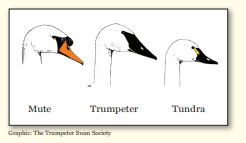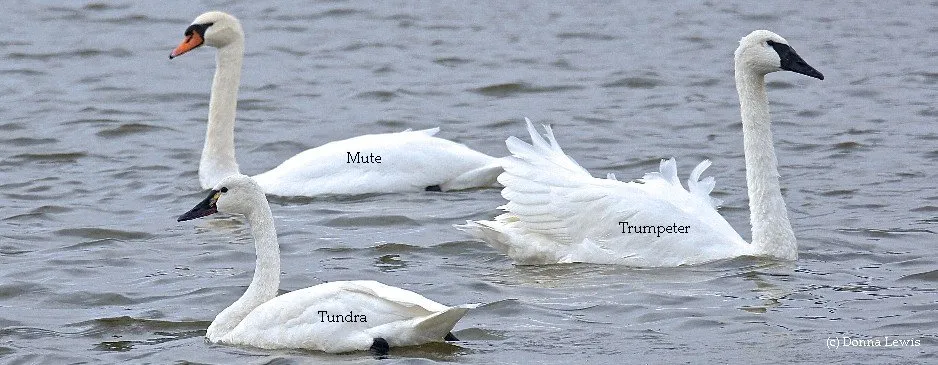Photo by Donna Lewis
As the mute swan population has exploded in the last few decades, so has the destruction of habitats attributed to their presence.
What’s Not to Love About a Swan?
Swans symbolize love, devotion, romance, clairvoyance, inner beauty, grace, and elegance. These birds are considered sacred in many cultures; to see them is a good omen and signifies peace and contentment.
They mate for life, raising clutches of cygnets year after year. When one of them dies, the other partner mourns their death for a long time; some swans even choose to spend the rest of their lives alone rather than seeking another mate.

The swans even epitomize love and romance in one of their courtship rituals. The swan couple faces each other, arching their necks to bring their faces closer to each other, forming a perfect heart.
Native vs. Invasive
There are three species of swans we see in Indiana:
- Trumpeter Swan (Cygnus buccinator) – State endangered species that have seen recent breeding success in some northern Indiana counties. Native to North America.
- Tundra Swan (Cygnus columbianus) – Breeds in remote Arctic areas and pass-through Indiana during fall migration to their wintering grounds along the mid-Atlantic coast. Native to North America.
- The Mute Swan (Cygnus olor) The most abundant swan in Indiana and can commonly be found year-round, except perhaps during very harsh winter weather. A Eurasian species that has been introduced and now breeds in the wild.
Invasive = Orange Beak
Native = Black Beak

The easiest way to differentiate mute swans from the other two species is that adult mute swans have an orange beak with a black border near their eyes and a black knob on top of their beak. Trumpeter and tundra swans have beaks that are completely black.
What’s the Issue?
An adult mute swan consumes up to eight pounds of aquatic and wetland vegetation per day. In addition, they uproot significantly more vegetation than they eat, some of which can wash ashore and create a problem for shoreline residents to clean up. During nest building, they can destroy large areas of wetland vegetation which can have a serious impact on water quality, aquatic habitat for fish and wildlife, and wetland functions. Major vegetation disturbance commonly leads to invasive species establishment. Mute swan feeding also reduces the available food sources that winter waterfowl and native birds require.
Mute swans are one of the world’s most aggressive waterfowl species and injure, kill, or displace native birds and other waterfowl. Adult mute swans may become especially aggressive toward people and pets in areas where they have become accustomed to food handouts. During the nesting season and rearing of young, mute swans have been known to aggressively drive off people and pets that enter their territory and have even knocked people from their boat.
Some say that mute swans drive away Canada Geese. While swans may keep geese at a distance, especially during periods of nesting and rearing of young, they will not drive geese away from waters, except for perhaps at a small farm pond. In fact, mute swans may push more geese onto lawns around waters where there is already an extensive amount of conflict between the geese and property owners.
DNR: Fish & Wildlife: Mute Swans (in.gov)
It seems magical when we see swans at the lake, but they are probably mute swans and therefore, not desirable. You may want to try to identify whether they are the mute or trumpeter swans and join a citizen science effort by reporting trumpeter swan sightings here. If we begin to see large numbers of mute swans, we may need to take action. For now, we can keep our distance and just enjoy their beauty.
For more information about trumpeter swans, visit Trumpeter Swan Society
Did You Know?
In the Christmas song “The Twelve Days of Christmas,” the seven swans a swimming stand for both the Seven Gifts of the Holy Spirit and the Seven Sacraments. The Seven Gifts of the Holy Spirit, as outlined in Isaiah 11.2-3 are: Wisdom, Understanding, Counsel, Fortitude, Knowledge, Piety and Fear (or, Respect) of the Lord. Now you know!

Hi, I’m Debbie Palmer. I received a BS in Horticulture from Purdue University. Here at LMEF, I am responsible for outreach presentations, monitoring the lake and it’s wetlands, project manager for restoration and research projects, and act as a community resource for all things related to the well-being of Lake Maxinkuckee and its surrounding watershed. I completed Indiana Watershed Leadership Academy, volunteer with the Indiana Clean Lakes Program, Hoosier River Watch and Marshall County Lakes and Waters and serve as a Board Member for Indiana Lakes Management Society.


Recent Comments